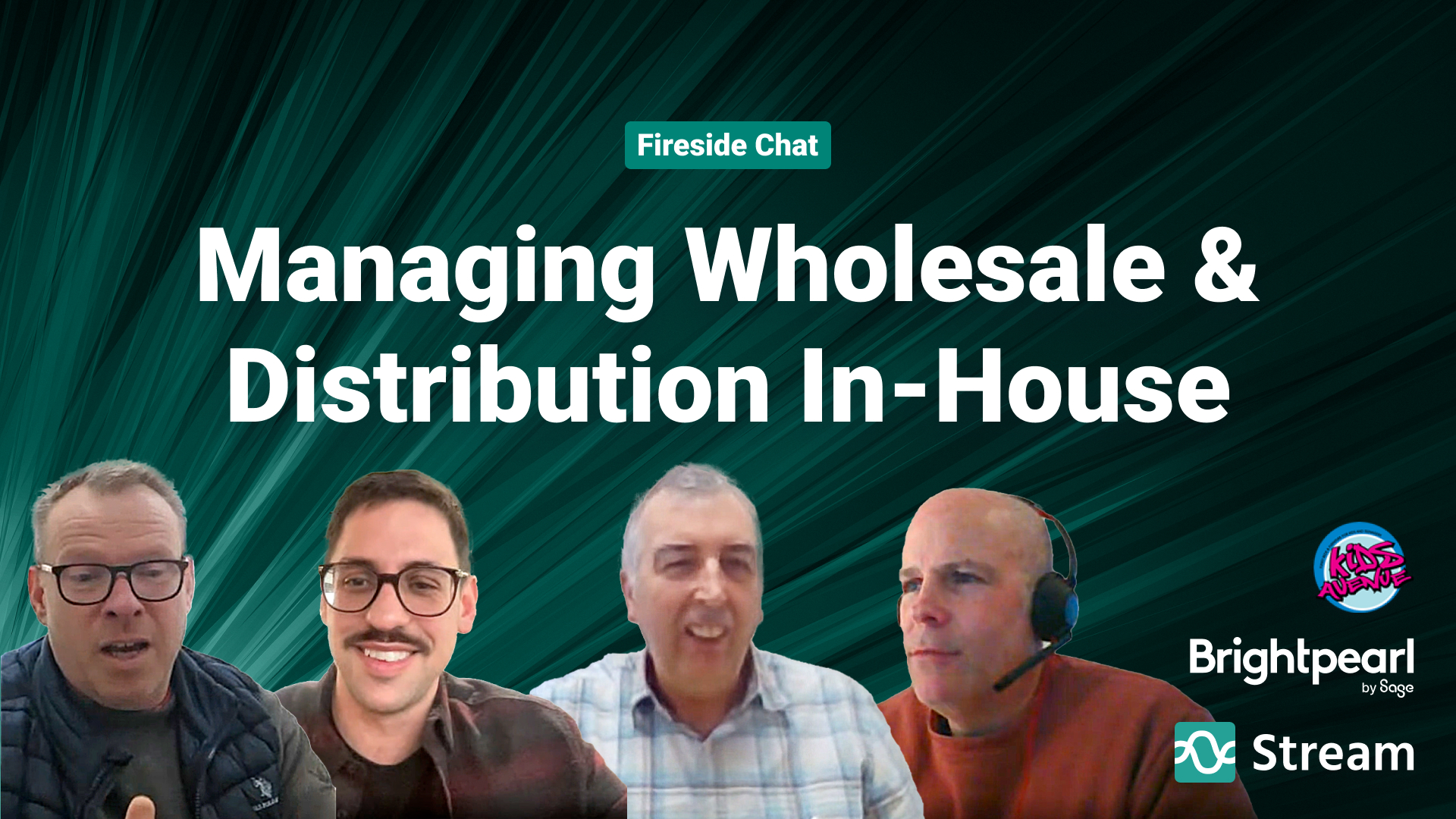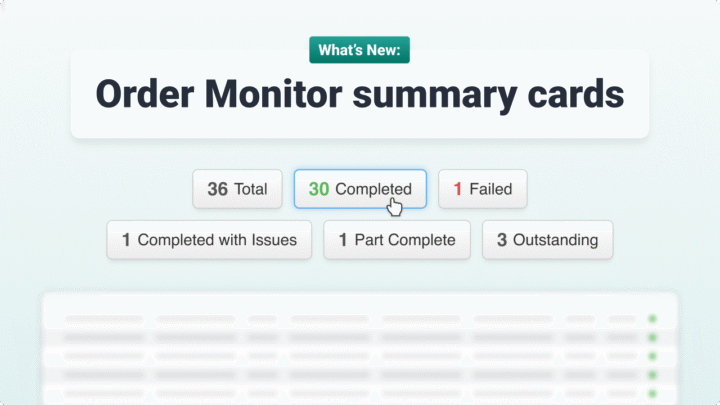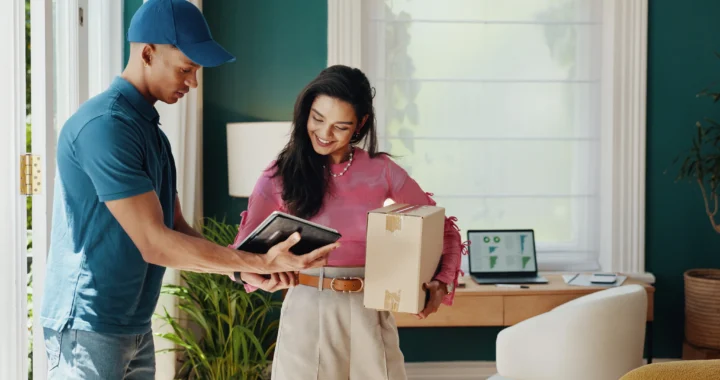We hosted a fireside chat, with some industry experts, to discuss the benefits of managing furniture wholesale & distribution in-house.
Managing a furniture wholesale and distribution business is complex at the best of times.
When you throw in the challenge of managing the delivery and assembly of that furniture, then the complexity is multiplied exponentially.
However, there are distinct advantages for wholesalers running their own logistics operation, as Scandinavian House, Stream’s first-ever subscriber can attest.
StreamTech’s Marketing Director, Paul Rufus, sat down with Dan Ridgway, joint Managing Director at Scandinavian House, to discuss both the challenges and benefits of managing their own logistics operation on behalf of their many retail customers and how they’ve been able to keep complete control of the customer experience from initial order to the customer’s door, and why seamless integrations between applications play a fundamental role in this process.
Joining Dan is David Sullivan, a Product Manager at Brightpearl by Sage, a retail operating system designed and developed specifically for the multi-channel retail and wholesale sectors.
With a tagline of ‘grow fearlessly’, Brightpearl by Sage can be deployed rapidly, whilst subscribers can take advantage of a host of integrations to streamline their operation, including product management, analytics, marketplaces and, of course, logistics, which brings us neatly onto the third industry expert on the panel, Dave Pickburn, managing director and CEO at Stream.
Dave has a (very) long history in designing, building and deploying transport and logistics solutions. A transport management system aimed at businesses with their own fleet of vehicles, making their own deliveries, Stream has been designed to integrate and work closely with third-party products, including Brightpearl.
StreamTech has worked with Scandinavian House for a number of years on the Stream product, and on the Brightpearl integration, which is the tightest (and longest-standing) integration of all the products that we deal with.
What are the benefits of managing wholesale & distribution in-house?
One of the things that has set Scandinavian House apart from other furniture wholesalers, in the 24 years they have been in business, is that their retail customers (which include the likes of Dreams, Barker & Stonehouse, Flair Furniture, and Next) is that they don’t ‘touch‘ any of the products themselves.
Whenever a Scandinavian House product is sold, the Scandinavian House team manages those individual orders all the way from the point that the order is placed with the retailer (ensuring stock is available through their two warehouses) through to final fulfilment using their own home delivery service, along with assembly if required.
Dan Ridgway emphasised the importance of ‘owning the whole process’, and by definition the customer service element of that operation:
“Having a system that enables us to track stock and integrate orders, and then be able to home deliver them through the two warehouses, bearing in mind that the industry classifies our products being long, bulky, heavy items as ‘ugly freight’, gives us full control of our inventory, and of our orders, by doing everything in-house.
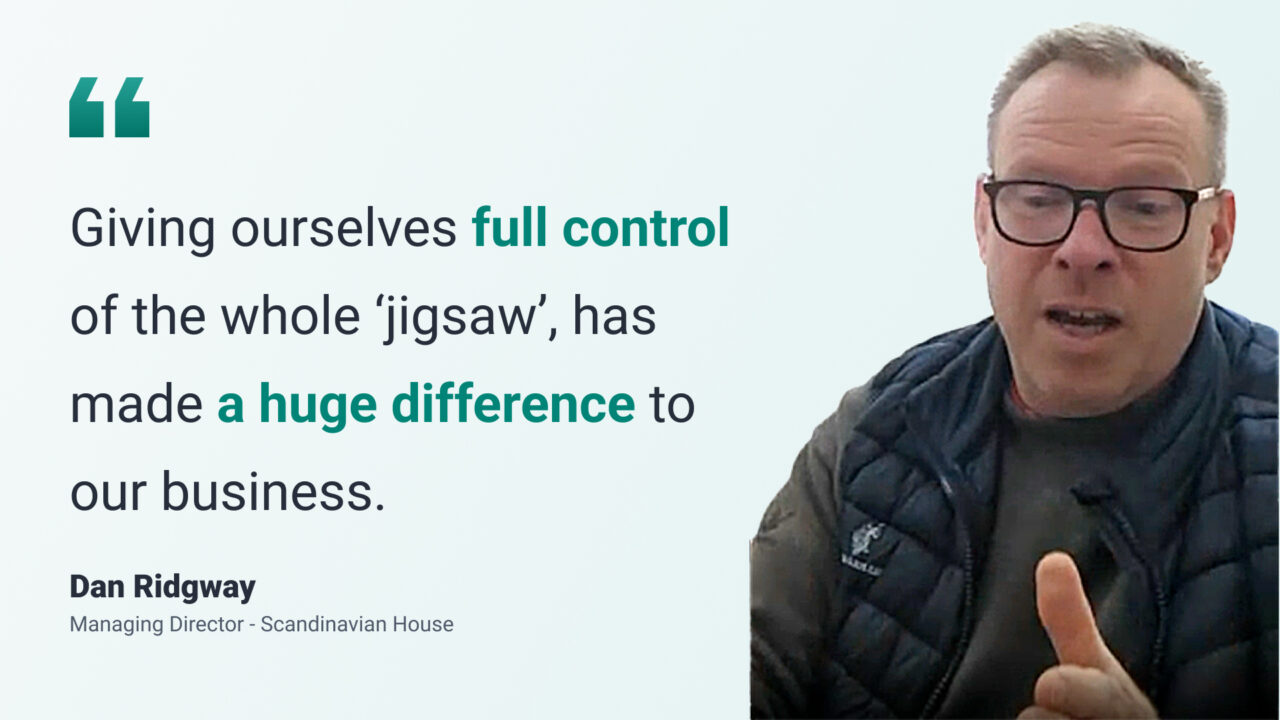
“We’ve learned, if you like, the hard way, by trying, when we first started, to do it with a parcel carrier was a disaster, because of the level of returns. There are a couple of reasonable two-man delivery options out there, but they’re absolutely stacked with work and that causes its own problems as well.
“So giving ourselves full control of the whole jigsaw, if you like, has made a huge difference to our business.”
Is it common for distribution operations to be done in-house?
When we take a look at the wider wholesale and distribution industry, there are a number of business functions that can be brought in-house outside of just own fleet deliveries.
In David Sullivan’s experience at Brightpearl, the picture is mixed depending on the type of products the business is selling:
“I’d say there’s a real mix and it really depends on the industry that people are operating in. So if there’s anyone who’s just working with packets and that size of thing direct-to-consumer, there’s no reason really to take control of that [process].”

Echoing the comments from Dan in the previous question, David does highlight that in-house becomes increasingly important when the business wants to ‘own the brand’ and ensure a certain customer service level throughout the business, especially when the product is big and bulky, or an added-value service is provided at the point of delivery such as assembly:
“I think where people want to bring it in-house is more when they need to own the brand. So you want your own stamp on it. You need to take it right through to the end of the process.
“Any part of the retail operations can be outsourced, but you want to have people who are knowledgeable, who are trained up to the level of service that you expect. Again, with a packet delivery, it’s not that big a deal. But when you’ve got people going into someone’s home, bringing stuff to the point that it’s intended to be used, even assembling it, providing a service well after the time of the sale, then yeah, I think it can be quite important to maintain ownership of that brand.”
In the furniture industry, where longer lead times between the point of order and the point of delivery are very often longer, there isn’t necessarily an expectation from the customer for rapid delivery, but high levels of customer service are very much expected and a way of differentiating one business from another.
Dan picks up the narrative:
“I think everything is expected the next day with the exception of bigger items. I think you wouldn’t expect a dining suite, or a sofa to be delivered the next day because you think it’s being made personally for you.
“At the same time, especially in our environment, it’s a considered purchase, because the room will be getting decorated, there’ll be carpet going down, it’s a new makeover for a whole room. So the lead time is important.
“But, there’s an exception that having the level of service that we offer, particularly with assembly, isn’t a next-day option. We can’t cover the country nationwide the next day with a delivery and assembly service, as you can when you send a parcel. If our boxes were all six inches square. It’d be fantastic. It would be a different business altogether. But sadly, it’s ugly freight and it takes a little bit more planning.”
The process of managing deliveries in-house
There are many elements to managing a delivery operation when ‘ugly freight’ comes into play.
Looking at Scandinavian House as our example, Dave Pickburn explains the various threads that they have to manage, and the plates they have to keep spinning:
“When you’re delivering quite a complex product, there’s not just one element being delivered. For each product being delivered, if it’s a children’s bed for example, it might have several components, all of which you’ve got to manage the stock for. You’ve got to marshal that stock into the right location and, as Dan mentioned earlier, you’ve got multiple warehouses. You’ve got to trunk it between those warehouses and keep track of that as you’re doing it and plan that delivery after it’s arrived there.”
“At the same time, there are a host of parties invested in the process who want, and need, to be kept up-to-date with each of the orders. The wholesaler themselves will want to be able to know exactly where every order and product SKU is throughout their operation; there’s the person who is at home and waiting for that delivery wanting to be able to track that progress; and you’ve got the retailer that’s actually sold those goods to the end consumer, and placed that order with Scandinavian House wanting to know what’s happening with that particular order.
Does managing distribution in-house help you remain in control of customer satisfaction?
Managing the delivery process internally, and owning the customer service of that process, can bring wholesalers a key market differentiator and significant competitive advantage.
Dan explains how delivering an exemplary home delivery service has enabled them to grow their business:
“Our biggest customer, Dreams, as an example, rely on us as their number one junior bedroom supplier. Which is great, but we’ve built on that business because of the whole package. It’s not just about the product, it’s about the level of service that we can offer and they’ve got a customer service team who trust and believe in what we offer.
Dan was keen to emphasise that trust (and the absence of noise as he put it) has been achieved through complete transparency in the entire customer order process, which has, in Dreams’ case, led to significant increases in order volumes.
How Stream helped reduce Scandinavian House’s phone bill by 60%
Not ‘creating noise’ is an interesting term, and one that Dave Pickburn was keen to pick up on by coining the phrase ‘quiet supplier’.
As well as describing Brightpearl as a quiet partner due to the robustness of their API integration, Dave picked up on one of the interesting, but slightly leftfield stats from Scandinavian House, regarding the drop of 60% on their phone bill.
“It’s a weird statistic. You think, what’s that got to do with software? But your phone bill dropped by 60% because mostly people stopped ringing you. But when they did ring, you could answer [their query] when they rang” commented Dave.
Picking up on that point, Dan said:
“I think even going further from that, I think we had, at that time, four lines into the business, and I know that they’re all IP lines now, but basically four open lines into the business to be able to speak to customer service.
“We’ve got two now and the phone is still not ringing, so we haven’t got the traffic coming into the office to the front house, as we call it, because a lot of the information is already provided for our customers who now trust in that system.”
The final soundbite from Dan in that section is worth mentioning (and brought a laugh to the proceedings):
“It’s just working so nice so that we don’t have the noise that we used to have and let’s never, ever go back there!”
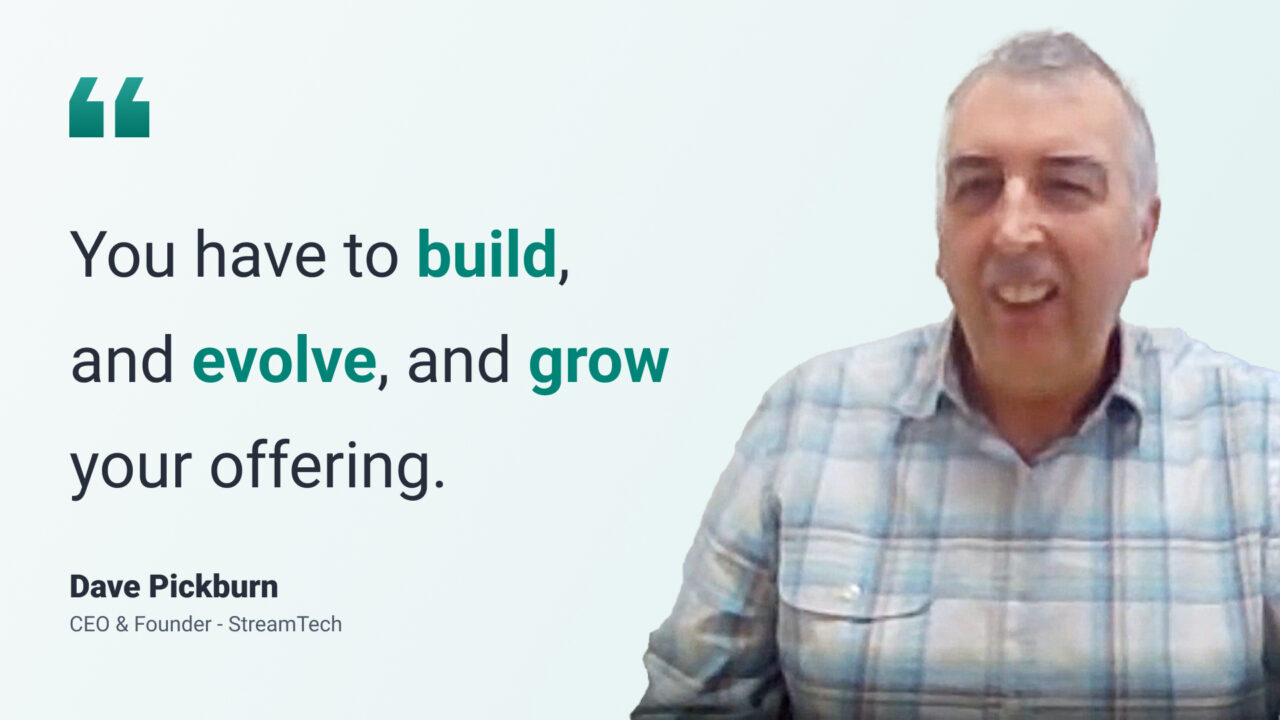
How has Brightpearl adapted to the marketplace in aiding wholesalers & distributors?
At this point in the discussion, we all went a little ‘off script’ and chatted about how software providers have to adapt to a changing world and the requirements from end-users.
“You have to build, and evolve, and grow your offering” commented Dave Pickburn.
Brightpearl, for instance, has gone through a number of changes over the eight years or so that Stream has been integrated, including being recognised as part of Shopify’s Global ERP Program, to acquiring Inventory Planner and then being acquired themselves by Sage.
As a product manager, David has a unique perspective on this particular question – one that is, admittedly, difficult to answer.
“There are a lot of people that use Brightpearl for slightly different things and it’s been pulled to meet different needs over that time. I don’t feel like there’s one straight answer and obviously within that time we’ve had the pandemic, and I know it comes up in every discussion like this, but it’s such a big thing and has impacted all our industries in such a big way that it’s kind of hard to ignore it.
“I feel like off the back of that time, we kind of saw patterns in how people were using the system and the other systems that they were integrating to as well. But it kind of harks back to the thing you were saying a second ago, that you do need to be able to change and adapt as you grow.”
Next David talks about the need for applications to be able to integrate with each other.
This is a wider subject, but this particular author thinks that it is a subject worthy of a discussion all of its own. Personally, I think the days of a ‘one-size-fits-all’ software package are gone. Customers are looking for ‘best-in-breed’ applications that meet the needs of a specific aspect of their operation, which brings us onto the wonderful world of ‘ecosystems’.
Again, David picks up the thread:
“It became even more important for Brightpearl to facilitate that through that time and to make sure, even if we couldn’t meet the customers needs in the core platform, that we have an integration or an app that you can then get hold of that would facilitate that for you”.
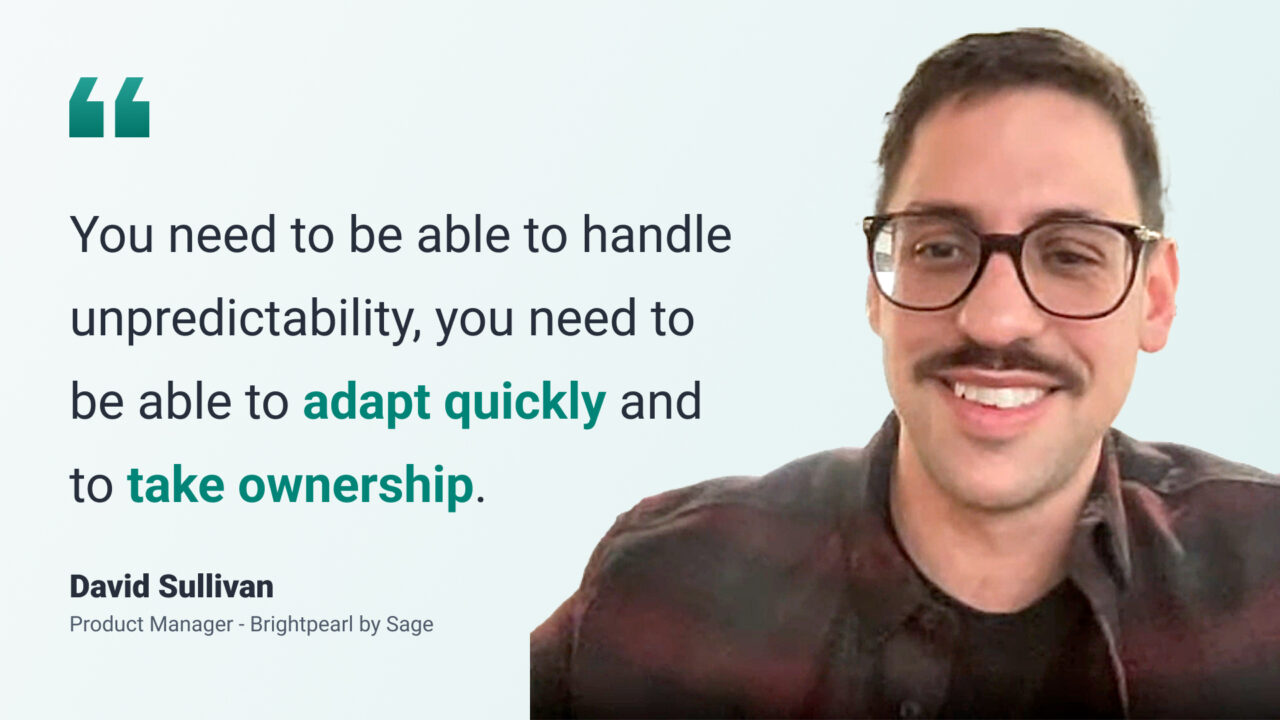
David then goes on to give some specific examples that have impacted retail, but interestingly he comes back to the primary message of being able to adapt, cope and handle unpredictability, which David says has often come down to the ability to automate processes with your operation:
“There are a lot of different phrases that have been kicking around over the past couple of years, like ‘adaptive retail’, ‘unified commerce’, ‘omnichannel’ a couple of years ago, but they’re all kind of referring to a similar set of values, in that you kind of need to be able to handle unpredictability, you need to be able to set up to adapt quickly and to take ownership, no matter how it is that you’re reaching your customer base. In that sense, we’ve found that making sure that you have standardised ways of integrating to things.”
“So something that we definitely saw was that being able to automate parts of your process offers up a level of consistency that you can give people across these different routes into their market. So suddenly adding in a new sales channel doesn’t mean that you have to figure out every little detail of how that works, because you know your business and you know the people who are going to be consuming your product. Ultimately, you can kind of handle like 80% of those cases just through being able to automate things and understand the state that an order needs to be in.”
David then proceeds to talk about one of my favourite phrases (and probably overused), ‘managing by exception’:
“Then you can start to focus on the exceptions, like the outliers you start to look at. A business can start to look at how they look after those exceptions, what they need to do about it, and free up resource to make sure that they’re actually investing their time and efforts into things that are valuable to their business when human intervention is valuable.”
And just to finish off this particular section, a real gem for our times, “it’s just that adaptability and that ability, or the ability of our system, to accommodate the need to adapt, that has just become more important than ever.”
Can better customer service help to grow your business?
In this next section of the discussion, we explore the business benefit of delivering an excellent service throughout the operation.
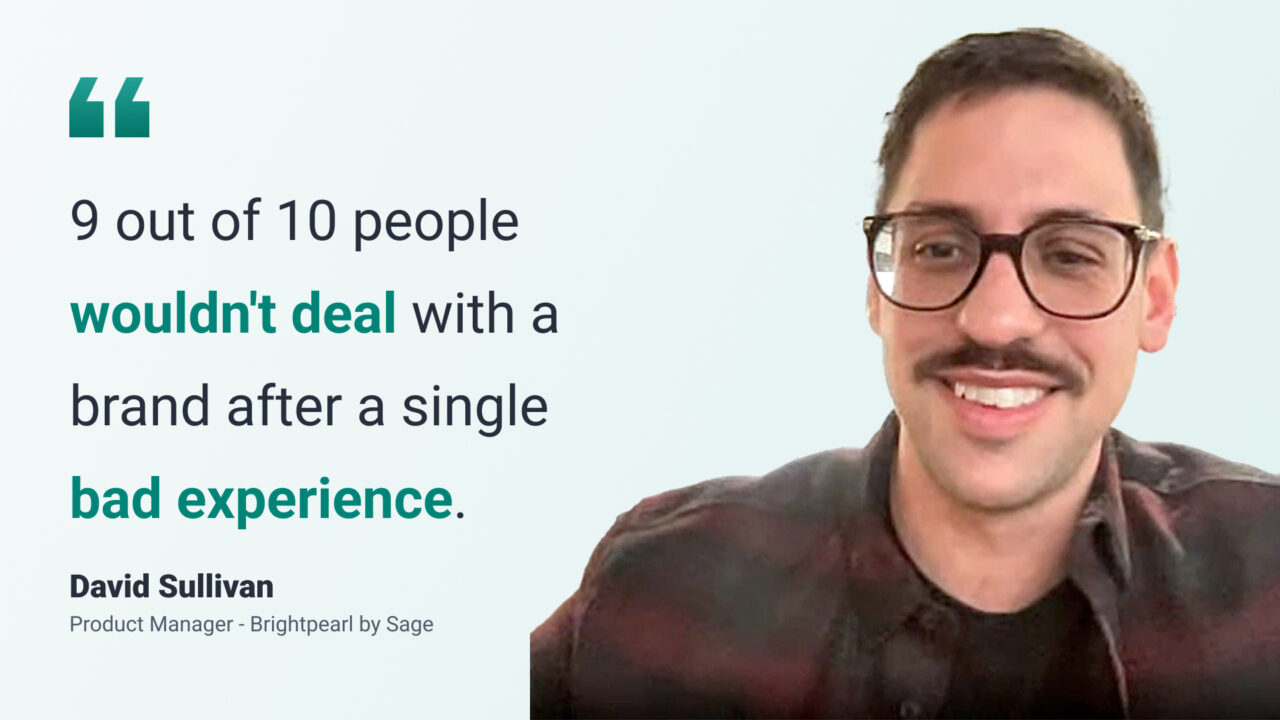
We’ve already touched upon the growth that Scandinavian House has been able to achieve with better customer service.
Dan provided an example of the January Furniture Show, a key event for connecting suppliers and distributors with retailers. Here, Scandinavian House showcases their latest products to new and existing retail customers, but the fact they are able to talk to them about the turnkey solution they provide is “music to their ears”:
“We’re not just selling the product, we’re selling the whole turnkey package, which is music to a buyer’s ears. When we can offer DHD [direct home delivery], they have no inventory issues. It’s all on us. We can also offer an assembly service. So then we’re listening to what they offer. We don’t sell direct, so we’re not a retailer. We’re only still looking at wholesale. We’ve made that decision. That may change in the future, who knows? But currently we’re happy with the customer base we’ve got. There’s nobody who can turn up at the Furniture Show who we couldn’t deal with, whether it’ll be a designer who wants one bed every year, or every six months to a large multiple.
“All the parameters or barriers have been removed by having the system and the setup we have, so we can deal with a really small customer or a massive customer, and it’s all using the same system.”
The power of integrations for in-house operations
Going back to the discussion about Brightpearl, and adapting to changes in the marketplace, there are points that David made there will be music to Dave’s ear.
For those that know him, he’s a stickler for the detail on how data will be moved from one application to another when integrating:
“It’s interesting. We spend a lot of time integrating with systems. But what we love is when someone comes along and says, I already have Brightpearl, or I’m thinking about what system I should use, and we’ve got an integration that’s ready to roll out within a few hours.
“We can get that up and running, get the inventory moving between the two, get the orders moving between the two, get the status updates flowing back. It’s great. Whereas of course, when you start with a brand new integration, you’ve got the analysis to do, you’ve got the work to do, and it takes time, effort, and money to do that.”
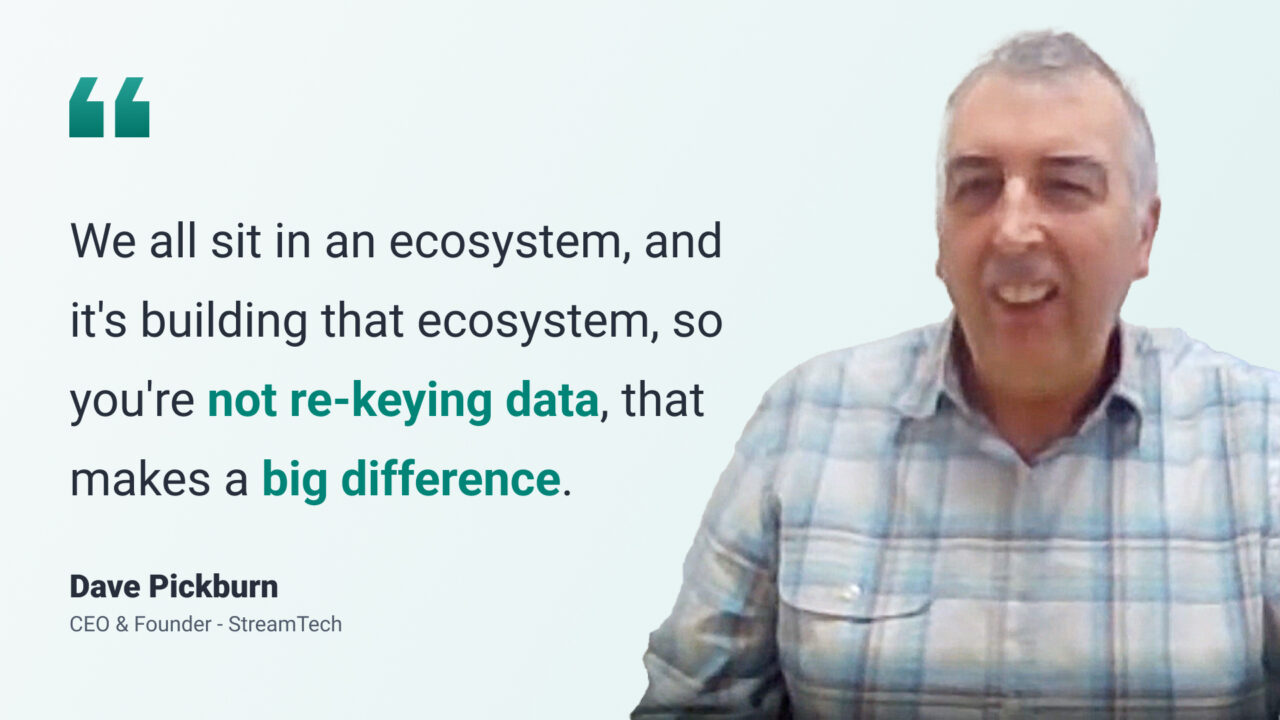
There’s a lot of ‘moving parts’ within an application like Stream. Internally, that ranges from Google Maps and gateways for sending SMS text message delivery notifications, through to Looker Studio and Power BI for analytics, cloud infrastructure for hosting, and everything in between.
Externally we’ve got a host of integrations available (Brightpearl included of course). As I alluded to earlier on, I think the days of single software providers offering a one-stop shop are long gone.
And Dave agrees:
“None of us, I don’t think, try to offer a toolset that we claim to be all you’ll need for your business. Because you remember back in the day, people used to come around and say, we’ve got the one-stop shop that will offer your IT solution for the whole business. I don’t think anyone tries or pretends that’s the case.
“We all sit in an ecosystem, and it’s building that ecosystem and building those integrations, so you’re not re-keying data, you’re not exporting spreadsheets and importing spreadsheets, you build it properly integrated. That makes a big difference. And like I say, when you’ve done it, and then you can kind of roll that out and switch that on for a new business as it comes along. It’s a win-win for Brightpearl, for us, and for whoever we’re doing business with. They can get up and running reliably.”
How important is the software ecosystem for customer service?
If we take Brightpearl’s marketplace for example, there’s a wide-ranging mix of applications that meet the needs of many different business functions and types of industry.
Obviously, if that business delivers goods and products in their own vehicles, then we hope they’ll be connecting Brightpearl with Stream for the logistics side!
But, own vehicle fulfilment is not the only methodology. They might be using the likes of UPS, Royal Mail or DHL for part, or all, of their deliveries.
“That whole ecosystem is incredibly important” commented David, before going on to recount a personal experience he had with the purchase of a new bed:
“Last year I bought a new bed, had it delivered, and it was a really good experience. They communicated really well with me, I’d chosen to have it assembled, and they sent me clear instructions about how I should prepare the space. They sent me over a 1 hour time slot without me asking for it but they offered me the option to reschedule it if I needed to, which already in my head I was thinking ‘okay, obviously, working for the company that I do, I can see about three, four apps that would need to sit in that chain of events.’ And then when they actually came out, it was an in-house delivery service.
“They arrived on time, or at least within the time frame, and they assembled the bed. There were no issues, they actually took some pictures of it and then they asked me to sign it off, and before they left the house, I got a confirmation email on my phone with the pictures with my signature on it”.
At this point David became moderator!
“Dan, you said earlier about the lead time thing, the expectation of lead times is coming down, and yet it’s still important. People still want to feel that you can respond quickly as someone selling that stuff, having that tight integration between things, understanding when you are going to be free, and being able to respond to any gaps in that schedule or have the right inventory at the right time. Again, Paul, you mentioned Inventory Planner a couple of times. This is an app that Brightpearl has as part of our offering, that’s really all about making sure that you have the right inventory at the right time.
“It analyses past sales and it makes purchasing recommendations, because as retailers, people don’t want their money tied up in stock, sat on shelves, or in outstanding purchase orders with their suppliers when they could be selling that stuff. All of these things tie together really closely and if you get it just right, then you can deliver a really powerful solution and really impress your customers.”
Having a joined up and integrated process, with the software to provide the glue is very important as Dan pointed out with the scenario David described:
“With Stream, we can send the email that you received for the notification of the booking. If, let’s say you bought it [the bed] from Dreams, it’s as if we [Scandinavian House] are part of the Dreams team, and it wouldn’t be until you spoke to the person who was assembling it that [you’d find out] they may be working for a different outfit altogether.”
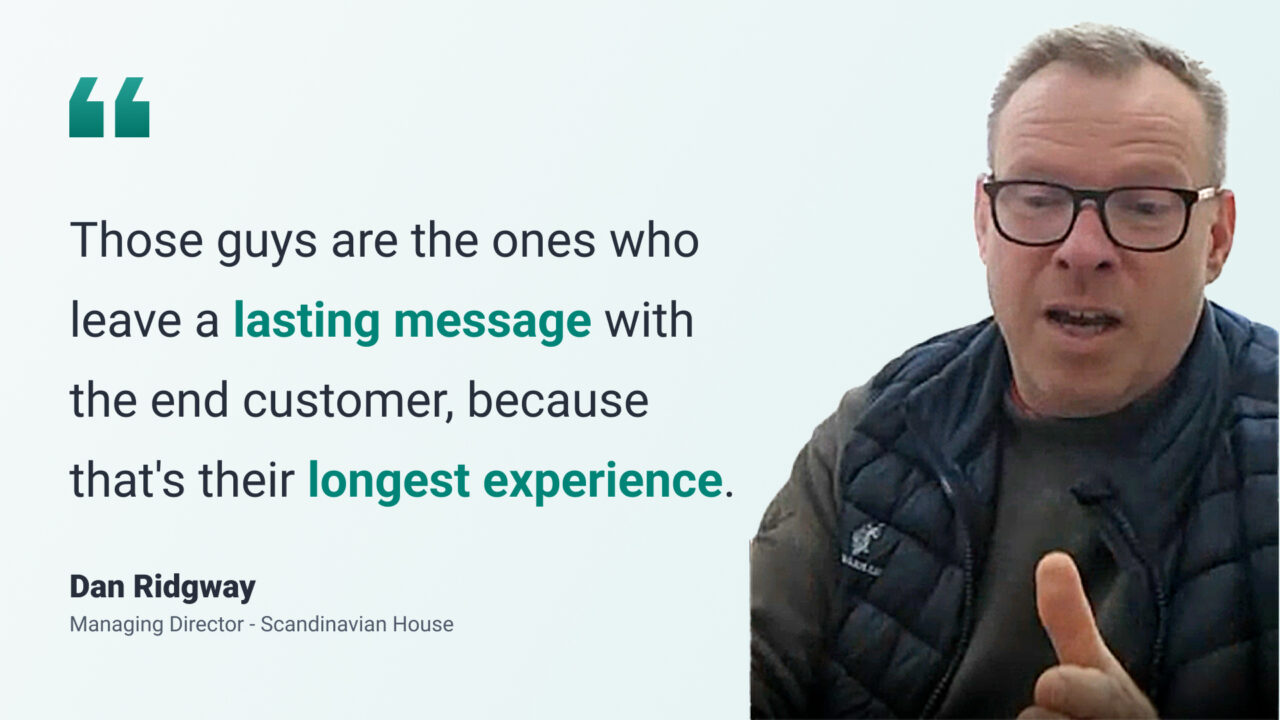
The customer has “got a contract with the retailer, and they are getting a delivery from, as far as they’re concerned, that retailer. And as long as that experience is seamless right the way through, as you’ve described, David, that’s what we would offer until the point of actually chatting to the guy who’s assembling it. And again, what’s really important, and that’s why the control and having it all in-house, I bet the guys in the house with you, delivering and assembling your bed, were [there] longer than the sales experience that you had.”
“Whether you bought online or in the store. Those guys are the ones who leave a lasting message with the end customer because that’s their longest experience. You might have bought online, never seen someone in the store. You might have gone on a Saturday morning or whenever. So it’s really important that those guys are punctual, efficient and polite and tidy up. It’s a whole package right to the end. But people do forget that the fitters can be on site for an hour and a half. They’ve had a longer customer experience directly with the end customer than any of the people in the chain beforehand.
Controlling the customer experience with in-house distribution & delivery
Controlling the whole customer service and customer experience is incredibly important, especially when products are being purchased online.
That person that comes to your door and delivers it is the only experience you have with that brand.
What’s very interesting (to me anyway), is providing that seamless experience across so many different sales channels, whether it be in-store, online or through a marketplace and then being able to provide that brand experience after the buy button is pressed.
And for David, that’s very much part of the experience.
“People want to be able to go and see some products in store, get some pricing, maybe get a quote online and act on it in their own time. So it’s really about closing the gaps between the different channels, even if it happens over many different channels. People want to feel like one experience all the way across the board. And you’re right, Dan, in that experience, that was the first time that I dealt with anyone face to face, because I just looked something up online and bought it. And I did get a good experience out of it, but I have had bad experiences.”
Brightpearl themselves have done research themselves on the impact of bad brand experiences.
“We did some research a while back and people who are dissatisfied with an experience would tell eight to ten people about it” said David. To offset it, it takes up to 12 positive reviews to offset one bad one and “nine out of ten people wouldn’t deal with a brand after a single bad experience.”
And, according to David, a lot of these things are just avoidable.
“Three quarters of these things are just to do with operational failure a lot of the time. Sometimes it’s to do with training, and sometimes it’s to do with that bad experience on site, but many of those things are really avoidable. By facilitating those people, by enabling the people that are going to have those important interactions with your customers, you’re really protecting your brand, you’re really playing to repeat business and customer loyalty.”
Keeping your customers informed on the progress of their order does “alleviate 90% of problems” according to Dave.
And although David is not looking to buy another product from the same retailer any time soon, he did concede that he would recommend them as it was a good experience.
The importance of managing customer experience by exception
For the final section of the discussion, we returned to the subject of managing by exception.
Earlier in the year, we analysed the data in Stream for all the deliveries completed in 2023. We discovered that about 5% were falling out of the allotted delivery slot.
Now, when you think about it, what that means is that the companies are only having to proactively deal with a small proportion of their deliveries.
Scandinavian House perform extremely well for delivering within their delivery windows, but that’s not the only factor (or it seems most important) in delivering customer excellence, which Dan went on to explain:
“Our planners know that we’ve got an hour or two-hour slot, but the planning will be at the beginning of that window. So if there’s any slippage due to traffic on the road, and we’re pretty accurate on the time for bills and deliveries, we’re always at the front end. So being within the zone shouldn’t actually be a problem. We may end up extending the stay, but it is important.
“The most important thing is that initial contact with the customer, because as soon as you’ve contacted the customer in the very first instance, they know that they’re in the pipeline, there’s a process, they’re being looked after, they can acknowledge the offered times that we’ve been given that removes all the noise because we know after that it will just happen.
“I can’t think of many circumstances where a customer is getting flustered because we are half an hour early or half an hour late within a slot that they want. It’s more about, as David said, in your overwhelmingly good experience, you had one small issue that got resolved quickly, and that’s what we will try and do, because we’re there, we’re taking photographs of the assembled bed. If there’s a shake or a knock that customers are unhappy with already, we’re already sending a replacement part to replace it. And it’s, ‘oh, fantastic. That’s great. I didn’t expect that.’ That’s kind of the next level. I think the window of time is not as crucial in our experience with our business.”
Automating processes can deliver exceptional benefits for businesses and, according to David, enable businesses to concentrate efforts on the ‘outliers’:
Brightpearl’s automation engine “saves people a lot of time. It can really reduce your running costs as your operational costs and it keeps human error down” commented David.
“What that means in practice is that nine out of ten things will progress without issue. You are then free to concentrate on those 10% of outliers. And when you concentrate on those, hopefully you’re not just mopping up after them, but you can start to say, okay, what we can do about these. Actually there are the same outliers. Maybe once in a 100 of deliveries, you might see a missed drilling or something like that. But for each of those, there’s got to be a best way of handling it.
“If you take ownership of that exception and you put your brand stamp on it and you work with those people, then you can turn it around and really make it into a win in the eyes of that customer.”
But, as Dave points out in the closing statement, there’s a lot that people take for granted (for all the right reasons), when we consider the complexities of a wholesale business, such as Scandinavian House, and the multiple sales channels they have, how they get those orders into Brightpearl and then through to Stream:
“Those orders go in and they’re all validated correctly, and they all flow through to Stream with the right address and the right products. And when stock is available, it really is available. And when stock’s not available, it’s really not available.”
About Scandinavian House
Scandinavian House is a specialist children’s bedroom furniture wholesale & distribution company, servicing retailers throughout the UK.
About Brightpearl
Launched in 2007 by the founders of retailer Lush Longboards, Brightpearl was acquired by Sage in 2020. Brightpearl by Sage is now one of the world’s leading retail operating systems that is built specifically for the retail and wholesale sectors. Brightpearl provides multi-channel merchants with the “freedom and flexibility to grow fearlessly” and was the first application Stream integrated with.
You can learn more about the Brightpearl integration with Stream here or find out about the application itself on the Brightpearl website
For more on the current state of e-commerce, read our ‘Navigating the Future of E-commerce: Key Strategies for Success‘ article. Or, discover the key trends shaping the online furniture market in 2025.
